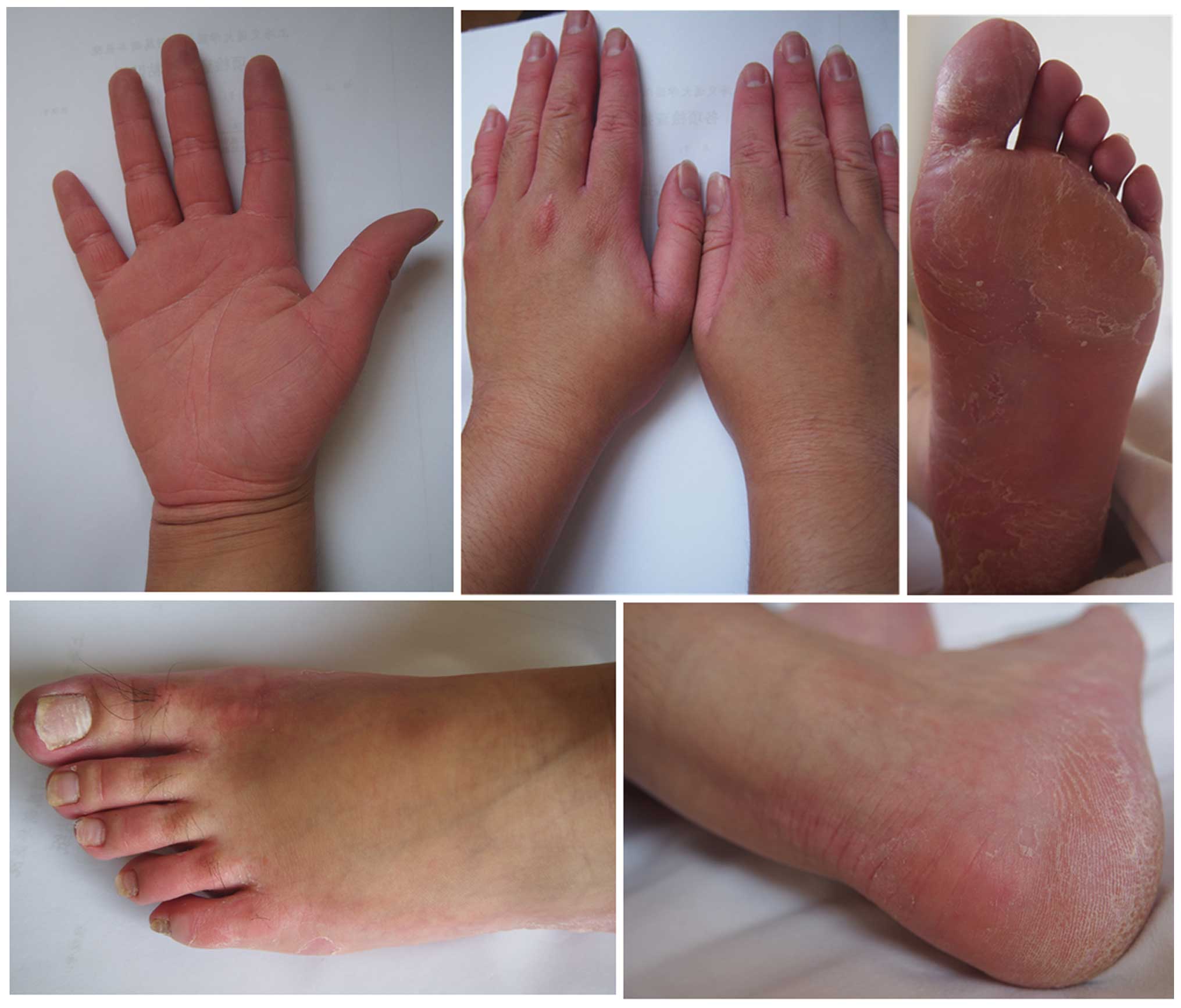|
1
|
Kabashima K, Sakabe J, Yamada Y and Tokura
Y: ‘Nagashima-type’ keratosis as a novel entity in the palmoplantar
keratoderma category. Arch Dermatol. 144:375–379. 2008. View Article : Google Scholar : PubMed/NCBI
|
|
2
|
Yin J, Xu G, Wang H, Zhao J, Duo L, Cao X,
Tang Z, Lin Z and Yang Y: New and recurrent SERPINB7 mutations in
seven Chinese patients with Nagashima-type palmoplantar keratosis.
J Invest Dermatol. 134:2269–2272. 2014. View Article : Google Scholar : PubMed/NCBI
|
|
3
|
Kubo A, Shiohama A, Sasaki T, Nakabayashi
K, Kawasaki H, Atsugi T, Sato S, Shimizu A, Mikami S, Tanizaki H,
et al: Mutations in SERPINB7, encoding a member of the serine
protease inhibitor superfamily, cause Nagashima-type palmoplantar
keratosis. Am J Hum Genet. 93:945–956. 2013. View Article : Google Scholar : PubMed/NCBI
|
|
4
|
Moosbrugger-Martinz V, Jalili A, Schossig
AS, Jahn-Bassler K, Zschocke J, Schmuth M, Stingl G, Eckl KM,
Hennies HC and Gruber R: Epidermal barrier abnormalities in
exfoliative ichthyosis with a novel homozygous loss-of-function
mutation in CSTA. Brit J Dermatol. 172:1628–1632. 2015. View Article : Google Scholar
|
|
5
|
Gruber R, Hennies HC, Romani N and Schmuth
M: A novel homozygous missense mutation in SLURP1 causing Mal de
Meleda with an atypical phenotype. Arch Dermatol. 147:748–750.
2011. View Article : Google Scholar : PubMed/NCBI
|
|
6
|
Mizuno O, Nomura T, Suzuki S, Takeda M,
Ohguchi Y, Fujita Y, Nishie W, Sugiura K, Akiyama M and Shimizu H:
Highly prevalent SERPINB7 founder mutation causes pseudodominant
inheritance pattern in Nagashima-type palmoplantar keratosis. Br J
Dermatol. 171:847–853. 2014. View Article : Google Scholar : PubMed/NCBI
|
|
7
|
Hida T, Okura M, Kamiya T and Yamashita T:
Nagashima-type palmoplantar keratosis caused by compound
heterozygous mutations in SERPINB7. Eur J Dermatol. 25:202–203.
2015.PubMed/NCBI
|
|
8
|
Mokni M, Charfeddine C, Ben Mously R,
Baccouche D, Kaabi B, Ben Osman A, Dellagi K and Abdelhak S:
Heterozygous manifestations in female carriers of Mal de Meleda.
Clin Genet. 65:244–246. 2004. View Article : Google Scholar : PubMed/NCBI
|
|
9
|
Eckl KM, Stevens HP, Lestringant GG,
Westenberger-Treumann M, Traupe H, Hinz B, Frossard PM, Stadler R,
Leigh IM, Nürnberg P, et al: Mal de Meleda (MDM) caused by
mutations in the gene for SLURP-1 in patients from Germany, Turkey,
Palestine, and the United Arab Emirates. Hum Genet. 112:50–56.
2003. View Article : Google Scholar : PubMed/NCBI
|
|
10
|
Bchetnia M, Laroussi N, Youssef M,
Charfeddine C, Ben Brick AS, Boubaker MS, Mokni M, Abdelhak S, Zili
J and Benmously R: Particular Mal de Meleda phenotypes in Tunisia
and mutations founder effect in the Mediterranean region. Biomed
Res Int. 2013:2068032013. View Article : Google Scholar : PubMed/NCBI
|
|
11
|
Kubo A: Nagashima-type palmoplantar
keratosis: A common Asian type caused by SERPINB7 protease
inhibitor deficiency. J Invest Dermatol. 134:2076–2079. 2014.
View Article : Google Scholar : PubMed/NCBI
|
|
12
|
Silverman GA, Whisstock JC, Askew DJ, Pak
SC, Luke CJ, Cataltepe S, Irving JA and Bird PI: Human clade B
serpins (ov-serpins) belong to a cohort of evolutionarily dispersed
intracellular proteinase inhibitor clades that protect cells from
promiscuous proteolysis. Cell Mol Life Sci. 61:301–325. 2004.
View Article : Google Scholar : PubMed/NCBI
|
|
13
|
Sakabe JI, Kabashima K, Sugita K and
Tokura Y: Possible involvement of T lymphocytes in the pathogenesis
of Nagashima-type keratosis palmoplantaris. Clin Exp Dermatol.
34:e282–e284. 2009. View Article : Google Scholar : PubMed/NCBI
|
|
14
|
Sartore L, Bordignon M, Bassetto F, Voltan
A, Tomat V and Alaibac M: Melanoma in skin affected with
keratoderma palmoplantaris hereditaria (Mal de Meleda): Treatment
with excision and grafting. J Am Acad Dermatol. 61:161–163. 2009.
View Article : Google Scholar : PubMed/NCBI
|
|
15
|
He Y, Zeng K, Zhang X, Chen Q, Wu J, Li H,
Zhou Y, Glusman G, Roach J, Etheridge A, et al: A gain-of-function
mutation in TRPV3 causes focal palmoplantar keratoderma in a
Chinese family. J Invest Dermatol. 135:907–909. 2014. View Article : Google Scholar : PubMed/NCBI
|
|
16
|
Zhang J, Cheng R, Ni C, Liang J, Li M and
Yao Z: First Mal de Meleda report in Chinese Mainland: Two families
with a recurrent homozygous missense mutation in SLURP-1. J Eur
Acad Dermatol Venereol. 30:871–873. 2016. View Article : Google Scholar : PubMed/NCBI
|
|
17
|
Nakamizo S, Katoh N, Miyachi Y and
Kabashima K: Atypical nail dystrophy in a possible case of
Nagashima-type palmoplantar keratosis. J Dermatol. 39:470–471.
2012. View Article : Google Scholar : PubMed/NCBI
|













